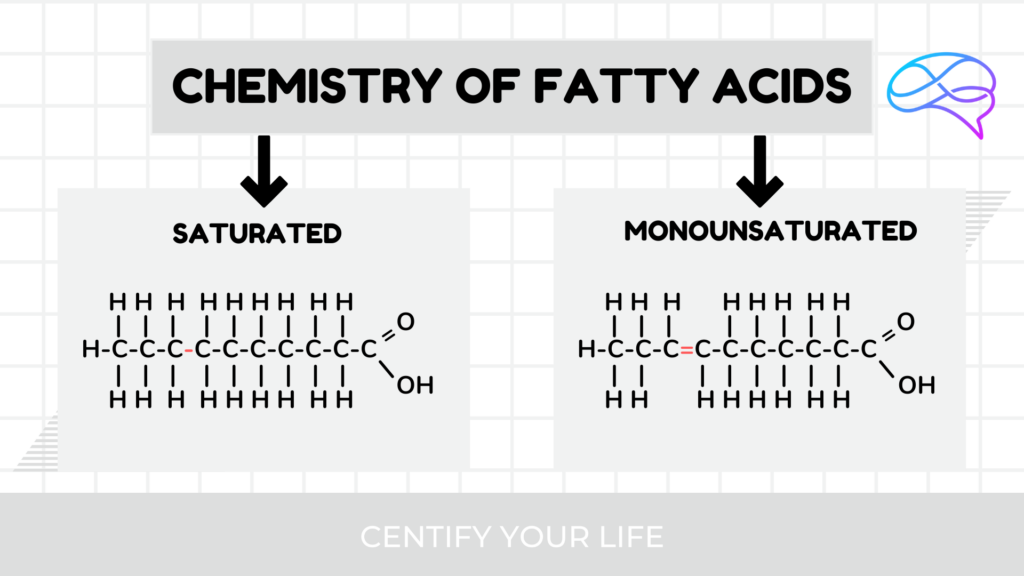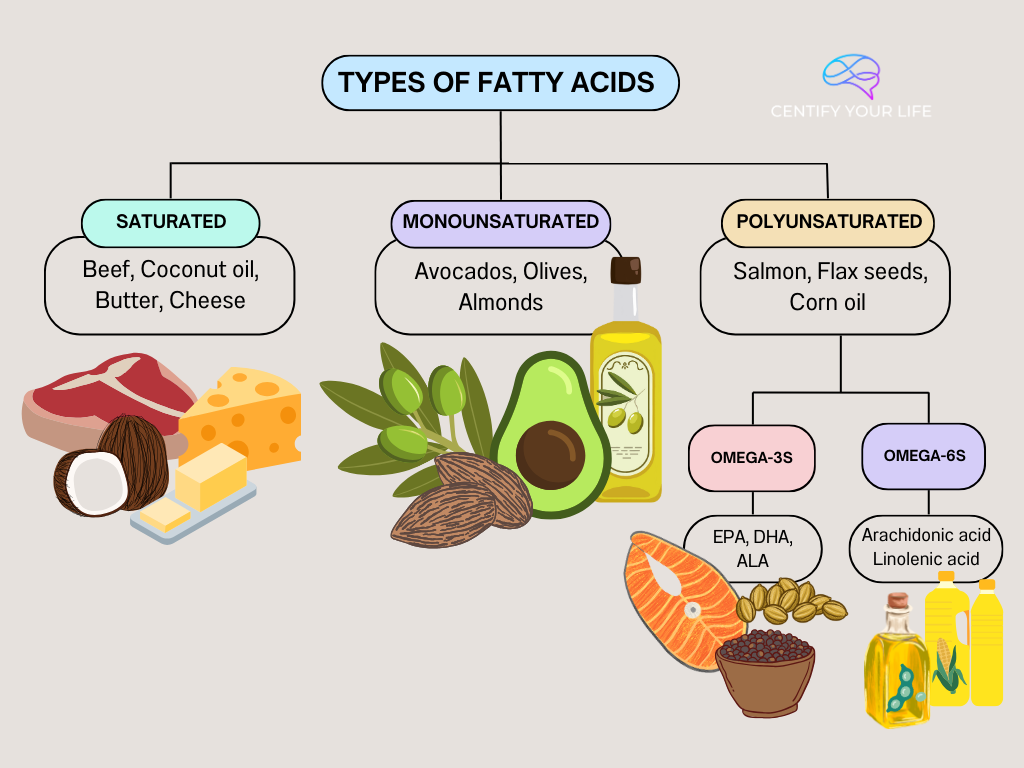All Things Omega-3
In a world full of highly refined oils, processed foods, nutritional deficiencies, and increasingly stressful lives, many of us struggle with chronic inflammation that can affect all aspects of our lives, including our heart, brain, skin, joints, and more. Could this be fixed through adding more omega-3s fatty acids to our diet? Let’s see what science says!
What are fatty acids?
A quick lesson in chemistry...
Fats can be broken down into 4 main categories: fatty acids, glycerides, nonglycerides, and complex lipids. Some fats are made of molecules called fatty acids. Fatty acids can come in forms that you’ve probably heard of: monounsaturated, polyunsaturated, and saturated. All of these names are ways for chemists to label the different structures that occur in fatty acids. The degree of “saturation”, i.e. unsaturated vs saturated, refers to the number of double bonds that exist between carbon atoms in these molecules. “Saturated” means that there are no double bonds between carbons of that fatty acid. “Monounsaturated” means that the fatty acid molecule has 1 double bond and the rest are single bonds. And “polyunsaturated” means that there are more than one double bond in the fatty acid molecule. Look at this picture below that shows an example. I think of the “saturated” molecule as being “saturated” with hydrogens (H) meaning no more hydrogens can be bound to the carbons in this fatty acid. However, the second molecule is unsaturated, and you can see that there is a double bond indicated by the 2 parallel lines (highlighted in red). This is important because these subtle changes in the ingredient chemistry can affect the physical/chemical properties of the fat and what reactions occur in the body once we ingest different types of fats.

What about trans fat?
Trans fat only entered the picture in the early 1900s when German chemist Wilhelm Normann exposed different oils (such as fish oil and vegetable oil) to hydrogen gas, hence forming partially hydrogenated oils. Once hydrogenated, these liquids became soft solids like margarine and vegetable shortening. This allows them to be shelf stable for long periods of time and be way cheaper than butter. However, trans fat has been linked to increase in LDL cholesterol, increased risk of heart disease, and increased chronic inflammation. Trans fats have recently been banned from food in the US, but be careful as some foods can contain trace amounts. Avoid anything with trans fat or “hydrogenated” on the ingredient label.1
Enough chemistry! Why should I care?
Most fat naturally contains all three of these fatty acids in different amounts. That’s right! For example, olive oil contains mostly monounsaturated fat and small amounts of saturated and polyunsaturated fats, while butter contains mostly saturated fat and small amounts of mono and polyunsaturated fats. To make things simpler, we usually categorize fats based on which type of fat is the majority of the food. Therefore, olive oil is categorized as monounsaturated and butter is considered saturated. Saturated fats are typically solids at room temperature. Some examples include beef tallow, butter, and coconut oil. Monounsaturated oils are usually liquid at room temperature. Examples of these oils include olive oil, avocado oil, and canola oil. Examples of polyunsaturated fats are fish oil, eggs, soybean oil, and vegetable oil. These oils are usually also liquid at room temperature and include omega-3 and omega-6 fats.

Omega-3 refers to a group of polyunsaturated fatty acids in our body. In short, omega-6s are considered inflammatory and omega-3s are anti-inflammatory. There are 3 main dietary omega-3 fatty acids: alpha-linolenic acid (ALA), eicosapentaenoic acid (EPA), and docosahexaenoic acid (DHA). Most of the research conducted and discussed below looks at the effects of EPA and DHA. ALA can be converted to EPA in the body, however the conversion rate is only about 2-6% depending on the person.2 Though more research on ALA is needed to show its distinct potential benefits, it does not currently show the same cardioprotective benefits as EPA and DHA. As you can see from the diagram above, omega-3 supplements only account for a one category of the fatty acid types found in our diets but it will be the primary focus of the rest of this article.
A note about inflammation
As you might be able to tell from the lists above, there are “good” and “bad” sources of each of these types of fats. This largely has to do with the types of fatty acids that the fat is composed of and which reactions they trigger within our bodies. Whole nuts and seeds are a great source of polyunsaturated fats (containing both omega-3s and omega-6 fats). This makes things confusing because you might have heard that omega-6 fatty acids are bad for you – leading to inflammation and increases in chronic illness. The truth is, we need both omega-3 and omega-6 fatty acids to optimize our health. Our body’s inflammatory response is after all designed to keep us safe, for example when a virus enters your body, your immune system is activated and an inflammatory response follows, raising your body’s core temperature (fever) to kill the virus. However, the amount of inflammatory omega-6 fatty acids that we consume in overwhelming quantities (in processed foods and highly processed oils) can lead us to have a very high omega-6:omega-3 ratio in our bodies. Omega-6s are precursors for pro-inflammatory molecules (cytokines) and therefore can support the pro-inflammatory pathways. It is known that in diseases such as rheumatoid arthritis, inflammatory bowel disease, and asthma, there are high concentrations of these inflammatory mediators at the disease site (i.e. joints, gut, lungs).3 Omega-3s, however, support the pathway to anti-inflammatory molecules like resolving and protecting.3 This is why it is believed that omega-3 supplementation can lead to anti-inflammatory effects in the body. To get more specifics about the biochemistry, check out reference!3
Prior to the boom in processed food and switching to vegetable oils, our ancestors consumed roughly 1:1 ratios of omega-3 and omega-6s. These days that ratio can be as high as 20:1 in some people.1 Measures in the blood of 3:1 to 5:1 omega-6:omega-3 are associated with better health outcomes2 (Keep reading for more specifics!). While we should definitely be conscious of eliminating highly processed foods and high omega-6 oils from our diets, we should not fear consuming some small amounts of omega-6s through whole foods like nuts and seeds as it naturally occurs with omega-3s.1
Should I take Omega-3 supplements? Let's break down the research!
Heart health
A 2022 meta-analysis of randomized control trials looked at the effect of omega-3 fatty acid supplementation on patients with Coronary Heart Disease (CHD). Each study included in the meta-analysis studied at least 1,000 patients and health outcomes were compared between the experimental and control groups. Comparing the results of 9 randomized control trials, omega-3 supplementation reduced the risk of major adverse cardiovascular events (MACE) by 5%. MACE includes cardiovascular death, non-fat ischemic stroke, and non-fatal myocardial infarction (MI) (heart attack). The risk of cardiovascular (CV) death decreased by 6% compared to control groups. Impressively, the meta-analysis also showed a significant decrease in MI of 14%.4
The meta-analysis also looked at patients who had a heart attack (MI) during the course of the trial. The study concluded that in patients with MI, omega-3 supplementation significantly reduced the occurrence of major adverse cardiovascular events (MACE) by 20% and CV death by 27%.4 Additionally, omega-3 supplementation has been shown to lower triglycerides, and reduce the tendency of thrombosis (blood clots) through limiting the formation of platelet aggregation factor and vasoconstriction.5
Brain health
Joints
Eyes
FAQ's about Omega-3s
Due to our modern diet, many people do not consume an ideal ratio of omega-6:omega-3. Adjusting this ratio by reducing your omega-6 rich refined oils and replacing them with high omega-3 containing foods can help reduce chronic inflammation. In order to help correct this ratio, many people have advocated for fish oil and other omega-3 supplements, noting their anti-inflammatory and cardioprotective benefits. Considering inflammation is the leading cause of so many chronic illnesses, adjusting your omega-6:omega-3 ratio can have many positive effects.
Omega-3s are a component found in fish oil supplements. Two omega-3s that you should look for in your fish oil supplement are EPA and DHA because they have shown the most improvement for patients in clinical trials.
Omega-3 supplements are an important supplement to incorporate, especially if you don’t consume oily fish! If dietary restrictions prevent you from taking fish oil, there are great omega-3 supplements sourced from algae! Be sure to look for a supplement with EPA and DHA, not alpha-linolenic acid (ALA) which is more easily sourced from nuts, seeds, and other plant based sources.
Just as it is important to buy good quality fish, it is equally important to buy high quality fish oil!
- Contains both EPA and EPA
- NSF or Informed Choice certified
- Sourced from low mercury fish (wild salmon, mackerel, anchovy, herring, sardines)
- At least 1-2 grams/day, or check your omega-3 index and adjust if more is needed!
If you have or are at high risk of having any of the conditions described above, you may want to talk to your doctor about having >2 grams/day (especially if you have low blood omega-3 values).
My favorite omega-3 supplement linked below!
My Two Cents!
Interested in reading more? Here’s our references!
- Hyman M. Chapter 8. What the Heck Should I Eat? – Fats and Oils. In: Hyman M. Food: What the Heck Should I Eat?. 1st ed. New York, NY: Little, Brown and Company; 2018: 147-170.
- Harris WS, Von Schacky C. The Omega-3 Index: a new risk factor for death from coronary heart disease?. Prev Med. 2004;39(1):212-220. doi:10.1016/j.ypmed.2004.02.030
- Calder PC. Marine omega-3 fatty acids and inflammatory processes: Effects, mechanisms and clinical relevance. Biochim Biophys Acta. 2015;1851(4):469-484. doi:10.1016/j.bbalip.2014.08.010
- Shen S, Gong C, Jin K, Zhou L, Xiao Y, Ma L. Omega-3 Fatty Acid Supplementation and Coronary Heart Disease Risks: A Meta-Analysis of Randomized Controlled Clinical Trials. Front Nutr. 2022;9:809311. Published 2022 Feb 3. doi:10.3389/fnut.2022.809311
- Li D, Wahlqvist ML, Sinclair AJ. Advances in n-3 polyunsaturated fatty acid nutrition. Asia Pac J Clin Nutr. 2019;28(1):1-5. doi:10.6133/apjcn.201903_28(1).0001
- Sohouli MH, Rohani P, Nasehi MM, Hekmatdoost A. Changes in serum brain-derived neurotrophic factor following supplementation of omega 3 fatty acids: A systematic review and Meta-Regression analysis. Clin Nutr ESPEN. 2023;56:207-214. doi:10.1016/j.clnesp.2023.05.019
- Sikka P, Behl T, Sharma S, et al. Exploring the therapeutic potential of omega-3 fatty acids in depression. Environ Sci Pollut Res Int. 2021;28(32):43021 – 43034. doi:10.1007/s11356-021-14884-5
- Sigaux J, Mathieu S, Nguyen Y, et al. Impact of type and dose of oral polyunsaturated fatty acid supplementation on disease activity in inflammatory rheumatic diseases: a systematic literature review and meta-analysis. Arthritis Res Ther. 2022;24(1):100. Published 2022 May 7. doi:10.1186/s13075-022-02781-2
- Ye H, Liu Y, Xu Z, Wei X. Fish Oil in Glaucoma Treatment: From Biological Functions to Clinical Potential. Mol Nutr Food Res. 2023;67(11):e2200727. doi:10.1002/mnfr.202200727

